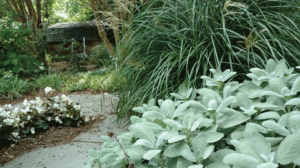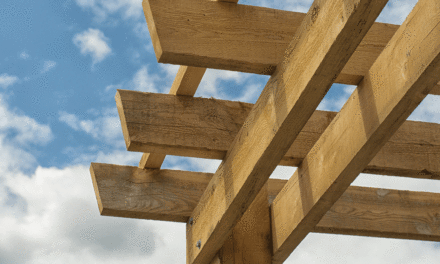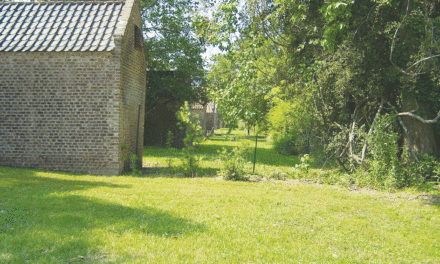
When colorful flowers aren’t the emphasis, texture and type, such as lamb’s ear and ornamental grass, stand out in a foliage garden. (Photo by Jan Kirsch)
A garden does not require “flowers” to be called a garden. Some of the most interesting gardens in the world rely on foliage to supply color and interest.
Leaves are also available in a variety of choices full of color, texture and form that can create a small shady area or an elaborate formal garden.
Award winning landscape designer, Jan Kirsch, gave this suggestion from her studio in Bozman between deliveries of new plants.
“How lucky I am to design gardens on the Eastern Shore! There are so many great plants with special characteristics that work well here. I love to use shrubs, grasses, perennials and trees that provide a visual treat for my clients in all four seasons,” she said. “In addition to flowers, my discerning clients appreciate unusual and colorful foliage plants with both bold and fine texture; plants that give them the ‘wow’ factor in their gardens.
“We have a lot of fun working together to make their outdoor living spaces reflect their personal style. There’s always something new ‘popping up’ for them to show off to their friends. “
Kirsch said there are many advantages to foliage gardens. Less maintenance is needed, since foliage gardens do not require deadheading.
Green is one of the most visually calming colors, so planting a foliage garden creates a calm, relaxing space.
A foliage garden can be a plant lover’s dream come true honing in on the textures, colors and shapes of the leaves. A foliage-focused garden holds it attractiveness for a longer season.
But the same rules of design apply to foliage plants as to flowers, she added.
• Plant in groups of three or more with contrast textures, forms and colors. In foliage gardens, there is no need to be concerned about the changing colors of flowers at different times of the year when planting the original design.
• Plant sun plants in sun, shade plants in shade.
• Plant water loving plants together and drought tolerant plants farther out.
• Yellow and green varieties contrast well with gray or purple leaved plants. Variegated or pattered leaves are best next to solid green. Brightly colored reds serve as a focal planting, with simple leaves nearby.
• Form and texture are very important when using leaves only for your garden. Large Hostas leaves look amazing next to the fern like leaves of a Bleeding-Heart. A tall vertical ornamental grass may do well to break up a bed of low growing sedums.
Suggested foliage-focused plants
• Begonias brighten up shady areas with their big, beautiful blooms. While most flowering plants require at least a half-day of full sun, begonias actually prefer growing in the shade and will bloom continuously from summer to fall.
• Ornamental grasses are garden staples. Graceful form and movement is captured as they dance with the wind. They also offer a variety of textures and colors.
• Ferns are easy to grow, long-lived and require zero care. They come in a wide range of colors, shapes, and sizes. Rarely do diseases or pests, including deer and rabbits, trouble them.
• Elephant ear plants have gigantic leaves that are never overlooked in the garden.
• Hostas are the ultimate shade plant-versatility, durability, limitless forms, sizes and shades of green-smooth or veined, waxy, cupped, puckered, ruffled, curled or twisted.
• Caladium leaves can be shaped like hearts, arrows, or lances in color combinations of red, pink, rose, white, chartreuse, and green.
• Coleus an easy-growing annual is available in many colors including a rich dark purple that adds pizzazz to shade beds.
• Golden Elderberries have dome-shaped clusters of creamy white flowers in late spring followed by showy clusters of red berries in fall.
• Spilled milk Pulmonaria (Bethlehem Sage) is a clump-forming, compact lungwort that features wide, brilliant silver foliage with tiny green speckles throughout and drooping clusters of pink flowers that bloom in early spring.





